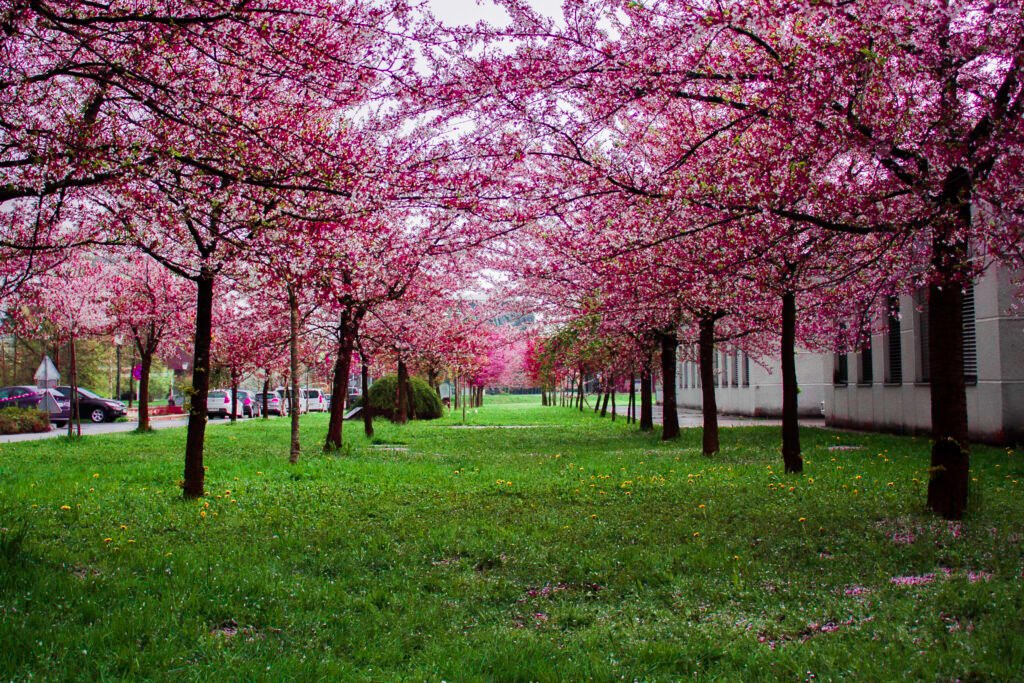The Cherry Blossom is a flowering plant from the genus Prunus, primarily known for its breathtaking beauty and cultural significance, especially in Japan. The blooming of cherry blossom trees symbolizes the arrival of spring. The tree’s lifespan is relatively short, and its delicate flowers typically bloom for only a week or two.
Cherry Blossom, also known as Sakura, are a beautiful species of flowering trees that originate from Asia. There are different types of Cherry Blossoms, such as the Yoshino Cherry, the Kwanzan Cherry, and the Okame Cherry.
Life Cycle
The life cycle of a Cherry Blossom tree begins as a seed, which grows into a small tree after about a year. The tree will start to produce blossoms after about three years, reaching full bloom around five years old. The tree can continue to live and bloom for many decades, with some known to be over a century old.
Bloom Season
The bloom season of a Cherry Blossom tree is typically in the spring, with the exact timing varying depending on the climate and specific variety of the tree. The blossoms last for about a week before falling to the ground, creating a beautiful snow of petals.
Characteristics
Cherry Blossoms have several attractive characteristics. They attract bees, butterflies, and hummingbirds, adding life and movement to your garden. They are also easy to grow and maintain, and their ornamental appeal is undeniable. Their blossoms are edible and fragrant, and they have an extended bloom time.
Growing Conditions
They grow best in full sun to part shade and prefer well-drained soil. They are adaptable to different soil types, including clay, loam, and sand, provided the soil is well-draining.
Resistance
In terms of resistance, Cherry Blossom trees are known for their resistance to deer. They are also resistant to certain diseases such as powdery mildew and rust. However, they can be susceptible to other pests and diseases if not properly cared for.
| Season | Depth | Height | Spacing | US Hardiness Zone |
|---|---|---|---|---|
| Spring | 2-3 inches | 20-30 feet | 15-20 feet | 5-8 |
Light Requirement
Cherry Blossoms require Full Sun to Partial Shade. They can tolerate a bit of shade but really thrive and bloom best when they get full sunlight.
Water Need
Water Cherry Blossom trees deeply and regularly, especially during dry periods. The soil should be moist but not waterlogged. Overwatering can lead to root rot and other diseases.
Fertilizer
Cherry Blossom trees prefer a balanced fertilizer with a ratio of nitrogen, phosphorus, and potassium such as a 10-10-10. Organic options could be compost or well-rotted manure.
Pruning
Regular pruning is needed to maintain the shape and size of the tree. The best time to prune is late summer or early fall, after the tree has finished blooming for the year. Pruning should be done carefully to avoid damaging the tree.
Toxicity
Cherry Blossom trees are non-toxic to humans, but the seeds inside the cherries contain cyanogenic glycosides, and if ingested in large quantities, they can be toxic to pets and livestock.
Common Issues
Common issues with Cherry Blossom trees include pests like aphids, caterpillars, and scale insects. Diseases like leaf spot, powdery mildew, and verticillium wilt can also affect these trees. To prevent these issues, ensure the tree is planted in well-draining soil, keep it well-watered, and use a suitable insecticide or fungicide if necessary.
Culinary Benefits:
- Cherry blossoms and leaves are edible and used in several traditional Japanese sweets and tea. They are often pickled and used in recipes for mochi and a jelly-like dessert known as Sakura-mochi.
- The blossoms are also used to flavor sake and can be found in other traditional Japanese dishes.
- In addition, they can be used to make aromatic and flavorful syrups, which can be used in various desserts and cocktails.
Medicinal Benefits:
- Cherry blossoms are rich in antioxidants and anti-inflammatory compounds, which can help to protect the body against damage from harmful free radicals.
- They have been used in traditional medicine for their sedative effects. It’s believed that they can help to calm the nervous system and promote a sense of relaxation.
- Cherry blossoms are also considered to be beneficial for the skin. They have moisturizing properties and can help to brighten the complexion, reduce inflammation, and soothe irritated skin.
- Some studies suggest that they can also support cardiovascular health and help to regulate blood pressure.
- In traditional medicine, cherry blossoms have been used to treat digestive disorders, respiratory ailments, and to promote longevity.
Companion Plants for Cherry-Blossom:
1. Azaleas: These stunning flowering shrubs complement the delicate beauty of cherry blossoms, creating a visually captivating garden.
2. Daffodils: The vibrant yellow flowers of daffodils provide a striking contrast to the soft pink or white cherry blossoms, enhancing the overall aesthetic of your garden.
3. Hostas: With their lush and variegated foliage, hostas create a beautiful backdrop for cherry blossoms, adding texture and interest to your garden.
4. Japanese Maples: These elegant trees not only provide shade and structure to your garden but also have foliage that complements the hues of cherry blossoms.
In conclusion, Cherry-Blossom is an exquisite and enchanting flower that can add a touch of elegance to any garden. With its delicate pink or white blossoms and symbolic significance, this plant is a favorite among gardeners and nature enthusiasts. Whether you want to create a serene and peaceful atmosphere or celebrate the arrival of spring, Cherry-Blossom is the perfect choice for adding beauty and tranquility to your outdoor space.

